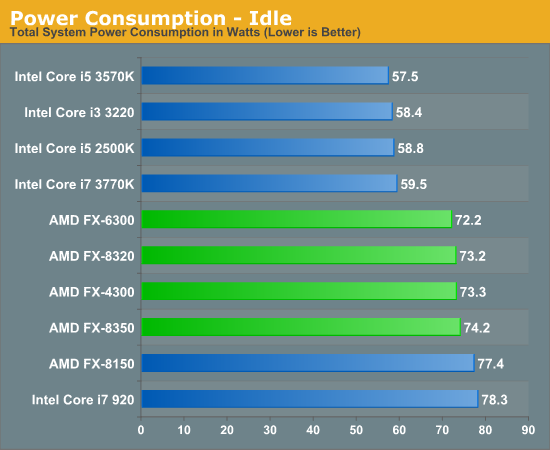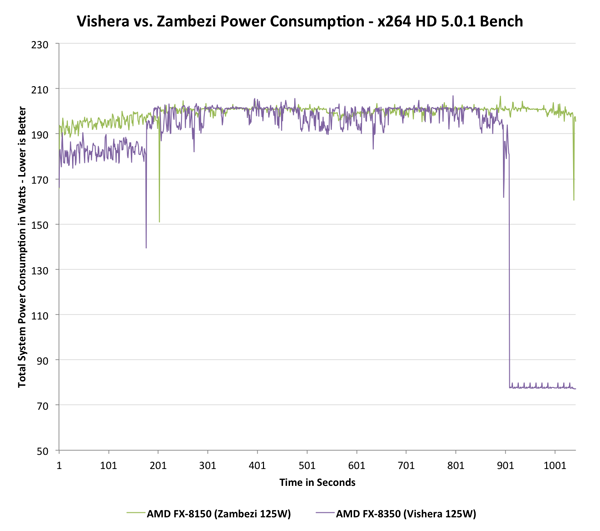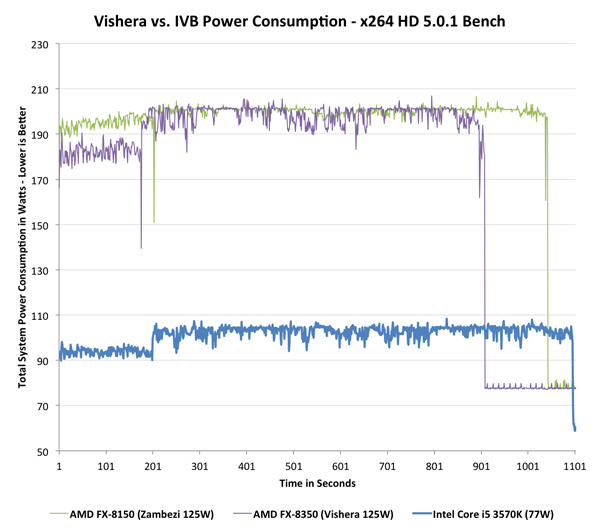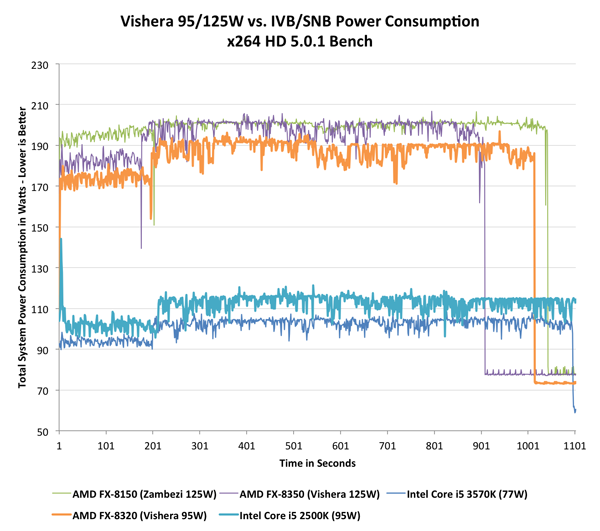The Vishera Review: AMD FX-8350, FX-8320, FX-6300 and FX-4300 Tested
by Anand Lal Shimpi on October 23, 2012 12:00 AM ESTPower Consumption
With Vishera, AMD was in a difficult position: it had to drive performance up without blowing through its 125W TDP. As the Piledriver cores were designed to do just that, Vishera benefitted. Remember that Piledriver was predominantly built to take this new architecture into mobile. I went through the details of what makes Piledriver different from its predecessor (Bulldozer) but at as far as power consumption is concerned, AMD moved to a different type of flip-flop in Piledriver that increased complexity on the design/timing end but decreased active power considerably. Basically, it made more work for AMD but resulted in a more power efficient chip without moving to a dramatically different architecture or new process node.
In mobile, AMD used these power saving gains to put Piledriver in mobile APUs, a place where Bulldozer never went. We saw this with Trinity, and surprisingly enough it managed to outperform the previous Llano generation APUs while improving battery life. On desktops however, AMD used the power savings offered by Piledriver to drive clock speeds up, thus increasing performance, without increasing power consumption. Since peak power didn't go up, overall power efficiency actually improves with Vishera over Zambezi. The chart below illustrates total system power consumption while running both passes of the x264 HD (5.0.1) benchmark to illustrate my point:
In the first pass Vishera actually draws a little less power, but once we get to the heavier second encode pass the two curves are mostly indistinguishable (Vishera still drops below Zambezi regularly). Vishera uses its extra frequency and IPC tweaks to complete the task sooner, and drive down to idle power levels, thus saving energy overall. The picture doesn't look as good though if we toss Ivy Bridge into the mix. Intel's 77W Core i5 3570K is targeted by AMD as the FX-8350's natural competitor. The 8350 is priced lower and actually outperforms the 3570K in this test, but it draws significantly more power:
The platforms aren't entirely comparable, but Intel maintains a huge power advantage over AMD. With the move to 22nm, Intel dropped power consumption over an already more power efficient Sandy Bridge CPU at 32nm. While Intel drove power consumption lower, AMD kept it constant and drove performance higher. Even if we look at the FX-8320 and toss Sandy Bridge into the mix, the situation doesn't change dramatically:
Sandy Bridge obviously consumes more than Ivy Bridge, but the gap between a Vishera and any of the two Intel platforms is significant. As I mentioned earlier however, this particular test runs quicker on Vishera however the test would have to be much longer in order to really give AMD the overall efficiency advantage.
If we look at average power over the course of the two x264 encode passes, the results back up what we've seen above:

As more client PCs move towards smaller form factors, power consumption may become just as important as the single threaded performance gap. For those building in large cases this shouldn't be a problem, but for small form factor systems you'll want to go Ivy Bridge.
Note that idle power consumption can be competitive, but will obviously vary depending on the motherboard used (the Crosshair Formula V is hardly the lowest power AM3+ board available):














250 Comments
View All Comments
CeriseCogburn - Tuesday, October 30, 2012 - link
LOL - seems like... hahahahhahahah in some imaginary future in a far off land, if and when and only if amd does xxxx and yyyyyy and blah blah blah blah,.... blew it.g101 - Wednesday, November 21, 2012 - link
More extreme ignorance from the idiot CeriseCogburn. Little boys who only game should seriously consider not commenting on things they aren't capable of comprehending.Stupid little bitchboy CeriseCogburn...What a waste of oxygen.
DDR4 - Wednesday, November 7, 2012 - link
nice to see AMD make better procs and lower their pricesandrewkoch - Friday, November 9, 2012 - link
If you live in an area that requires A/C most of the year like me, the true cost of owning a FX8350 processor is about an additional $100 year vs. owing a 3570k.Fx8350 +15 watts idle +95 watts load vs. i5 3570k
50 hours week light cpu usage = 75W
10 hours week heavy cpu usage = 760w
Combined usage = 1025w @$0.11 Kw/h = $1.12
A/C usage 75%-80% @$0.11 Kw/h = $.84
Extra electrical cost $2/week
Extra electrical cost $100/yearly or $300/3 years
Maybe my math is wrong, but if you use A/C most of the year and pay for electricity an AMD cpu is a waste of money. Then again some people still use incandescent light bulbs instead of compact fluorescent lamps or LED bulbs.
andrewkoch - Saturday, November 10, 2012 - link
LoL my math was wrong in the above post.Fx8350 +15 watts idle +95 watts load vs. i5 3570k
68 hours week light cpu usage = 1kW
100 hours week heavy cpu usage = 9.5w
Combined weekly usage = 10.5kw @$0.11 Kw/h = $01.15
Average A/C usage 80%*$1.15 @$0.11 Kw/h = $.0.92
Extra electrical cost $2/week vs. owing a 3570k
Extra electrical cost $100/yearly or $300/3 years vs. owing a 3570k
In this usage scenario the computer is heavily used for tasks like folding, gaming or video editing
criter - Saturday, November 17, 2012 - link
121117Intel is a semiconductor company first; and a microprocessor company second ($13.5B revenue [#3.8B quarter])
used to make a living making memory chips (dram) until they became commoditized by Japanese rivals in the 1980s and margins plunged, now volume produced microprocessors happen to be the most profitable;
makes more useable chips per $5B-300mm & $7B-450mm/+40to120% extra chips wafer fabs, (90% yield range vs 60 to 80% rivals), moving to 22nm geometries, 14nm by 4q13;
Chips take about 3 months to make and they are put through more than 300 separate processes
intel atom vs brit arm (less pwr & customizable, 98% of cellphones since 2005 have had arms in them) for touch panel (w8) mobile/cell phone/tablet mkt
i3 55W ceiling...
amd Piledriver (x86 architecture) retail Oct 2012, 4c, 8c, L2&3 16MB, am3+, ddr3, dx11, 32nm; 1st gen Zambezi; (pdriver performs +15% than bulldozer;)
FX4300 8MB/95w, 3.8GHz, $131, 4c
FX6300 14MB/95w, 3.5GHz, $176, 6c
fx8320 16MB/125w, 3.5GHz, $242, 8c
fx8350 16MB/125w, 4GHz, $253, 8c
K10 4q07 (phenom x4/IIx3/IIx4, gen3 Opteron), K8 2q03 (Athlon 64/64x2, Sempron 64), k7 3q99 (Athlon/xp, Duron, Sempron)
?Trinity apu (AcceleratedProcessingUnit, pdriver) architecture (2gen x86 cores) Oct 1, integrated gpu, 'fusion' fm2 formfactor (previous llano use fm1 socket), dx11 (shader5), (radion A4-7480 to A10-7660 hd gpu)
Merom mobile arch (1q06, 667-800MT/s, 35W, bga479, socketM&P; updated 65nm [fab] Yonah core P6[pentium pro '95]) marked Intel’s acknowledging that the Pentium 4 (netburst arch) was not a viable long term solution because power efficiency is crucial to success;
65nm Conroe desktop (core2 quad, 800 MT/s, 65W, lga775); Woodcrest (lga771) 1333 scaled down to 1066MT/s workstation (40W@1.6-1.86GHz, 80W 3GHz), server(xeon socket604&lga771);
differing socket(M,P,T,fcbga), bus speed and pwr consumption; the identical Core microarchitecture was designed by Israel's Intel Israel (IDC) team;
stepping represent incremental improvements but also different sets of features like cache size and low power modes;
Nehalem 45nm (16pipeline), Westmere 32nm; Sandy bridge 32nm, ivy bridg 22nm; Haswell 22nm, Broadwell 14nm; Skylake 14nm, Skymont 10nm;
sandy bridge 32nm integrated x86 microprocessor as SoC (cpu/gpu+last lvl cache+sys I/O) vs amd bulldozer
intel haswell dual-threaded, out-of-order cpu arch 22nm FinFET, (high end tablets, low pwr)
theoretical peak performance for Haswell is over double that of Sandy Bridge, twice the FLOP/s, cache bandwidth doubled, vs '13 amd Steamroller core & w8;
g101 - Wednesday, November 21, 2012 - link
What is this pile of copy/pasted shit?Principle - Thursday, November 29, 2012 - link
Why is it that every review I see, no one uses the RAM that the CPU memory controller is rated for? Or in overclocking, did you see what a RAM overclock added?Just because your Intel chip may not perform any better with 1333, 1600, or 1866, doesnt mean you dont run your AMD chip with the 1866 its rated for. I see this all over the review sites. You dont have to use the same RAM in both systems for a comparison of CPU performance. RAM choice is designed into the CPU, and has an affect.
ThaSpacePope - Monday, December 3, 2012 - link
Nice job AMD. I guess some of these benchmarks are skewed because windows 8 is superior to windows 7 because it uses the modules better, but still.. the $166 8350 outperforms in some cases or comes close to the performance of a $200 i5-3570k.This is great news for AMD. Keep up the good work!
jreyes2254 - Thursday, December 20, 2012 - link
I find it funny all the Intel lovers are hating on so called AMD "fanboys."Isnt defending Intel and hating on AMD in turn make you all Intel "Fanboys."?
...Intel has not served me well I havent used one since my ol P4... I gladly claim the title of AMD "Fanboy.".
I have this CPU, Its pretty Epic.